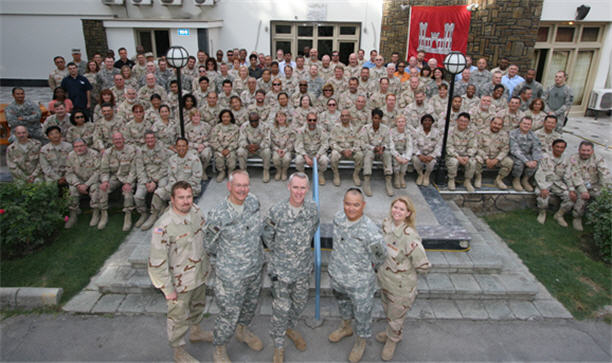

U.S. Army Corps of Engineers (USACE) through its Afghanistan Engineer District (AED) provides quality, responsive engineering and construction services to a variety of customers in Afghanistan. AED performs a crucial role in the international efforts to facilitate establishing a secure and stable environment in Afghanistan while promoting reconstruction and infrastructure development.
More than 200 U.S. civilian and military personnel are assigned to AED. They manage programs and projects that support a full spectrum of regional activities for the International Security Assistance Force (ISAF); Combined Security Transition Command – Afghanistan (CSTC-A) and Regional Command – East, both of which are U.S. commands; U.S. Agency for International Development (USAID); and other organizations operating in Afghanistan.
These efforts generally fall into four major program areas:
1) Afghan National Security Forces Program
CSTC-A acts in partnership with the Afghanistan Government and the international community to plan, program and implement reform of the Afghan police and defense sectors to strength the rule of law and deter terrorism within the borders. USACE contributes to the Afghanistan Security Forces Program by designing and constructing facilities for the Afghan National Army, Afghan National Police and other defense sectors.
Typical facilities consist of barracks, dining, administration, maintenance, utility systems and other associated structures to meet mission requirements. To date, AED has completed or has under construction facilities that accommodate more than 50,000 Afghan Army soldiers; and AED has completed more than 100 facilities for the police program, while working toward an end state of nearly 700 facilities.
2) U.S./Coalition Forces Power Projection Program
Under this program, USACE provides engineering and technical support to the Department of Defense and its military construction requirements in Afghanistan. These requirements include runways, airfield facilities, ammunition supply points, military housing, operations centers, and associated infrastructure and utility systems.
3) Counter-Narcotics/Border Management Initiative (CN/BMI Program)
This program oversees the construction of forward operating bases and border crossings, as well as other projects such as the National Investigative Unit, Judicial Center and Joint Aviation Facilities in Afghanistan.
4) Strategic Reconstruction Program
Through this program, the AED staff works with CSTC-A, USAID, donor nations and agencies to identify areas where projects have an immediate effect building alternative livelihoods, creating ownership and eroding enemy support.
Some of the projects are funded by the Commander’s Emergency Relief Program and include projects such as water management studies, alternative power initiatives, and construction of national and provincial roads and micro-hydro power stations. Construction is complete on more than 884 kilometers of roads with another 1,434 kilometers projected for fiscal year 2007.
Road projects are critical for two primary reasons. First, they provide improved access for coalition, Afghan National Army and Afghan police forces to ensure security throughout the country. Second, road projects improve access for Afghan people to participate in governance, education, health, trade and other development projects. In addition, the Afghanistan and Tajikistan Governments have commissioned the construction of a 673-meter weathering steel girder bridge. The bridge will support two lanes of commercial traffic plus pedestrian and cart traffic and open up a landlocked country to more commercial trade.
Building Afghanistan’s National Capacity
AED is committed to doing its part to help build Afghanistan’s national capacity. On any given day, as many as 14,000 Afghans are at work on Corps projects scattered around the country. The number of workers is expected to increase to 20,000 by the summer of 2007 as a result of the AED’s increased workload and the initiatives to place more work with Afghan nationals and firms. The number of Afghan construction firms submitting proposals on AED’s projects has significantly increased. As of December 2006, 70 percent of AED contract awards went to Afghan or Afghan-American firms.
In addition, more than 120 Afghans work directly for AED, 49 of who are in engineer/supervisory positions. AED engineers also partner and support Afghan facility engineers at various project sites.
AED will continue to provide valuable engineering and construction services to support the development and execution of U.S. and international efforts to establish a secure and stable environment in Afghanistan. The Corps of Engineers estimates that it will manage approximately $2.07 billion in program funds in fiscal year 2007, a significant increase over FY 2006.
View Our Latest Freedom Builder Issue